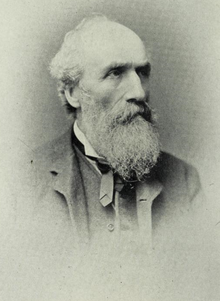
George Skene Keith (11 March 1819 – 12 January 1910) M.D., F.R.C.P., LL.D was a Scottish physician, photographer and author.
Biography[edit]
Keith was born in St Cyrus.[1] He took his M.D. degree in 1841 and was admitted a licentiate of the Royal College of Surgeons of Edinburgh (RCSEd). He became a Fellow of the RCSEd in 1845.[1] Keith was a Gold Medallist in Professor James Young Simpson's class at University of Edinburgh.[2]
His father was minister Alexander Keith. In 1844, he visited Palestine with his father for five months and took some of the earliest photographs of the region.[3][4] He took 30 daguerreotypes, eighteen of which were published as engravings in his father's book Evidences of the Truth of the Christian Religion in 1848.[3][5][6]
In 1847, Keith took part in an experiment with James Young Simpson and colleagues which demonstrated the use of chloroform upon humans as an anaesthetic.[1] Keith practiced medicine successfully in Edinburgh until 1880 but later became disillusioned with the medical community and embraced simple living.[1] He was not fond of drugs, instead he prescribed little food, fresh air, plenty of hot water and rest to his patients.[7][8]
Publications[edit]
- Plea for a Simpler Faith (1897)
- Plea for a Simpler Life (1897)
- Fads of an Old Physician (1897)
- On Sanitary and Other Matters (1900)
- Plea for a Simpler Life: And, Fads of an Old Physician (1900)
References[edit]
- ^ a b c d George Skene Keith, M.D., Ll.D., F.R.C.P.E. British Medical Journal, vol. 1, no. 2560, 1910, pp. 237–238.
- ^ George Skene Keith, M.D., F.R.C.P., LL.D. Edinburgh Medical Journal 4: 150
- ^ a b Gernsheim, Helmut; Gernsheim, Alison. (1968). L. J. M. Daguerre: The History of the Diorama and the Daguerreotype. Dover Publications. p. 159
- ^ Hannavy, John. (2008). Encyclopedia of Nineteenth-Century Photography, Volume 1. Routledge. p. 476. ISBN 978-0-415-97235-2
- ^ Moscrop, John James. (1999). Measuring Jerusalem: The Palestine Exploration Fund and British Interests in the Holy Land. Leicester University Press. p. 48. ISBN 0-7185-0220-5
- ^ Marien, Mary Warner. (2002). Photography: A Cultural History. Laurence King Publishing. pp. 52-53. ISBN 978-1-85669-493-3
- ^ Plea for a Simpler Life, and Fads of an Old Physician. JAMA. 1900:XXXV (6): 371.
- ^ Gillespie AL. A Plea for a Simpler Life, and Fads of an Old Physician. Edinb Med J. 1900;8 (4):356–357.
Well, that’s interesting to know that Psilotum nudum are known as whisk ferns. Psilotum nudum is the commoner species of the two. While the P. flaccidum is a rare species and is found in the tropical islands. Both the species are usually epiphytic in habit and grow upon tree ferns. These species may also be terrestrial and grow in humus or in the crevices of the rocks.
View the detailed Guide of Psilotum nudum: Detailed Study Of Psilotum Nudum (Whisk Fern), Classification, Anatomy, Reproduction